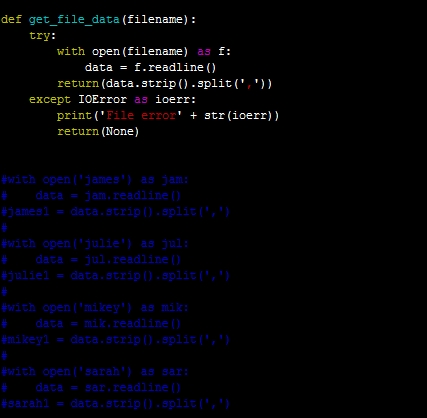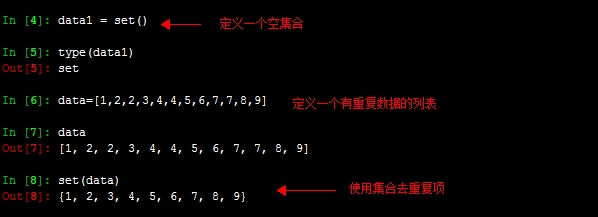一、把下面这组数据进行处理,进行规则排序。
第一版代码:
|
1
2
3
4
5
6
7
8
9
10
11
12
13
14
15
16
17
18
19
20
21
22
23
24
25
26
27
28
29
30
31
32
33
34
35
36
37
38
39
40
41
42
43
44
45
46
47
48
49
50
51
52
53
54
55
56
57
|
#!/usr/local/python3/bin/python3
#定义了一个函数,用来做数据的分隔符转换,保证数据风格的一致,才能有效排序。
def
sanitize(time_string):
if
'-'
in
time_string:
splitter
=
'-'
elif
':'
in
time_string:
splitter
=
':'
else
:
return
(time_string)
#将取到的一段数据,通过判断中定义的分割符切开为两组,分别报存到mins,secs变量中。
(mins,secs)
=
time_string.split(splitter)
#在返回结果的时候,完成字符串合并。
return
(mins
+
'.'
+
secs)
#使用with open打开文件,和open不同于with open会自动关闭文件,不需要手动关闭。
with
open
(
'james'
) as jam:
data
=
jam.readline()
#把数据进行首尾去空格,使用,最为分隔符切分。
james1
=
data.strip().split(
','
)
#这里也可以通过这种方式排序,在最后输出的时候,直接输出james2就可以了。
#james2 = sorted(james1)
with
open
(
'julie'
) as jul:
data
=
jul.readline()
julie1
=
data.strip().split(
','
)
#julie2 = sorted(julie1)
with
open
(
'mikey'
) as mik:
data
=
mik.readline()
mikey1
=
data.strip().split(
','
)
#mikey2 = sorted(mikey1)
with
open
(
'sarah'
) as sar:
data
=
sar.readline()
sarah1
=
data.strip().split(
','
)
#sarah2 = sorted(sarah1)
clean_james
=
[]
clean_julie
=
[]
clean_mikey
=
[]
clean_sarah
=
[]
#通过迭代每组数据,调用sanitize函数,再把转换好的数据添加到新的列表中,这样列表中的数据风格就是一致的。
for
each_t
in
james1:
clean_james.append(sanitize(each_t))
for
each_t
in
julie1:
clean_julie.append(sanitize(each_t))
for
each_t
in
mikey1:
clean_mikey.append(sanitize(each_t))
for
each_t
in
sarah1:
clean_sarah.append(sanitize(each_t))
#输出新列表并排序
print
(
sorted
(clean_james))
print
(
sorted
(clean_julie))
print
(
sorted
(clean_mikey))
print
(
sorted
(clean_sarah))
|
输出结果:
这就完成了规则排序。
二、需要给数据去重复,排序,只输出前三项数据。
第二版代码:
|
1
2
3
4
5
6
7
8
9
10
11
12
13
14
15
16
17
18
19
20
21
22
23
24
25
26
27
28
29
30
31
32
33
34
35
36
37
38
39
40
41
42
43
44
45
46
47
48
49
50
51
52
53
54
55
56
57
58
59
60
61
62
63
64
65
66
67
68
69
70
|
#!/usr/local/python3/bin/python3
def
sanitize(time_string):
if
'-'
in
time_string:
splitter
=
'-'
elif
':'
in
time_string:
splitter
=
':'
else
:
return
(time_string)
(mins,secs)
=
time_string.split(splitter)
return
(mins
+
'.'
+
secs)
#定义函数来解决去除重复数据项的问题,此函数接受两个列表作为参数带入,当数据不存在新列表中就把数据添加到新列表,如果有存在则不会添加,代替了下面使用每个列表使用for迭代的方式,代码更简洁。
def
pomoto(old_list,new_list):
for
i
in
old_list:
if
i
not
in
new_list:
new_list.append(i)
with
open
(
'james'
) as jam:
data
=
jam.readline()
james1
=
data.strip().split(
','
)
with
open
(
'julie'
) as jul:
data
=
jul.readline()
julie1
=
data.strip().split(
','
)
with
open
(
'mikey'
) as mik:
data
=
mik.readline()
mikey1
=
data.strip().split(
','
)
with
open
(
'sarah'
) as sar:
data
=
sar.readline()
sarah1
=
data.strip().split(
','
)
unique_james
=
[]
unique_julie
=
[]
unique_sarah
=
[]
unique_mikey
=
[]
#从迭代的方式改为了列表推导的方式
clean_james
=
sorted
([sanitize(each_t)
for
each_t
in
james1])
clean_julie
=
sorted
([sanitize(each_t)
for
each_t
in
julie1])
clean_mikey
=
sorted
([sanitize(each_t)
for
each_t
in
mikey1])
clean_sarah
=
sorted
([sanitize(each_t)
for
each_t
in
sarah1])
#调用函数完成去重复
pomoto(clean_james,unique_james)
pomoto(clean_julie,unique_julie)
pomoto(clean_mikey,unique_mikey)
pomoto(clean_sarah,unique_sarah)
#每列表迭代方式的去重复
#for i in clean_james:
# if i not in unique_james:
# unique_james.append(i)
#for i in clean_julie:
# if i not in unique_julie:
# unique_julie.append(i)
#for i in clean_mikey:
# if i not in unique_mikey:
# unique_mikey.append(i)
#for i in clean_sarah:
# if i not in unique_sarah:
# unique_sarah.append(i)
#输出去重复后的唯一新列表,只打印前三项数据
print
(unique_james[
0
:
3
])
print
(unique_julie[
0
:
3
])
print
(unique_mikey[
0
:
3
])
print
(unique_sarah[
0
:
3
])
|
输出结果:
三、使用集合删除重复项,将重复的with open定义为函数,简洁代码,进行逆序排序,输出前三项。
第三版代码:
|
1
2
3
4
5
6
7
8
9
10
11
12
13
14
15
16
17
18
19
20
21
22
23
24
25
26
27
28
29
30
31
|
#!/usr/local/python3/bin/python3
def
sanitize(time_string):
if
'-'
in
time_string:
splitter
=
'-'
elif
':'
in
time_string:
splitter
=
':'
else
:
return
(time_string)
(mins,secs)
=
time_string.split(splitter)
return
(mins
+
'.'
+
secs)
#定义函数打开文件获取数据返回,并加入了错误处理代码。
def
get_file_data(filename):
try
:
with
open
(filename) as f:
data
=
f.readline()
return
(data.strip().split(
','
))
except
IOError as ioerr:
print
(
'File error'
+
str
(ioerr))
return
(
None
)
#调用函数直接得到文件中经过切片后的数据。
james1
=
get_file_data(
'james'
)
julie1
=
get_file_data(
'julie'
)
mikey1
=
get_file_data(
'mikey'
)
sarah1
=
get_file_data(
'sarah'
)
print
(
sorted
(
set
([sanitize(i)
for
i
in
james1]),reverse
=
True
)[
0
:
3
])
print
(
sorted
(
set
([sanitize(i)
for
i
in
julie1]),reverse
=
True
)[
0
:
3
])
print
(
sorted
(
set
([sanitize(i)
for
i
in
mikey1]),reverse
=
True
)[
0
:
3
])
print
(
sorted
(
set
([sanitize(i)
for
i
in
sarah1]),reverse
=
True
)[
0
:
3
])
|
输出结果:
定义get_file_data函数代替了,多行的with open,使得代码简洁。
Python 集合数据结构:集合中的数据项是无序的,而且不允许重复的,这和我们数学中的集合很像。
最后print输出代码:
本文转自qw87112 51CTO博客,原文链接:http://blog.51cto.com/tchuairen/1678435






